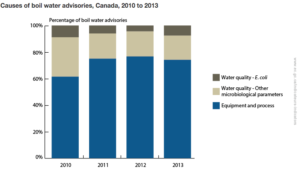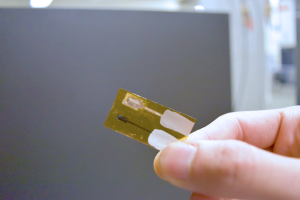Delivering clean water is a complex issue that is often over simplified. Clarity, turbidity, colour, contaminants, and many other parameters all need to be analyzed and adjusted before water is delivered to households. Among these factors, chlorine and pH levels are extremely significant; incorrect levels of chlorine and pH can lead to incomplete disinfection and long-term health risks for community members.

“In 2013, 74% of boil water advisories in Canada were caused by equipment and process issues,” says Dr. Jamal Deen, distinguished university professor at McMaster University.
Dr. Deen is leading an IC-IMPACTS project where his team is truly innovating in the water monitoring field. His objective is to change the current paradigm of water monitoring in rural communities in order to reduce health risks and provide cleaner and safer water.
Empowering Rural Communities
In Canada, many small and rural communities have tremendous issues ensuring that the chlorine and pH levels for their drinking water meet the levels specified by the provincial and federal governments. Although the water sensing technologies in these communities are advanced, the instruments are highly technical and can only be used by trained professionals who visit these communities intermittently.
By creating a solution that is both simple and easy to use, community members can operate the water sensing technologies themselves and understand the status of their water at any given point without the need for external technicians.



Creating Innovative Solutions
Dr. Deen and his research team are creating a point-of-use device that can sense chlorine and pH in real time. The device is designed to be small and easy to use for community members. By adding wireless capabilities to these devices the water sensing data could then be transmitted to professionals such as the Public Health Agency of Canada, who can then analyze the data remotely and contact the community to issue a water advisory before an illness occurs.
The team uses carefully prepared metal oxides that can be solution processed or printed for their pH sensors, dramatically reducing the overall manufacturing costs for large scale productions. They recently demonstrated printed bifunctional carbon nanotubes to great success, also used for pH sensing.
Perhaps the project’s most interesting innovation is this project’s use of readily available materials. The team’s pH sensors are simply made using an inkjet printer in their lab. These printed sensors can be produced locally around the world as long as a community has an inkjet printer and the appropriate cartridges. The project’s chlorine sensors mainly use functionalized graphite, meaning the graphite commonly found in most lead pencils can be functionalized and used as a very accurate chlorine sensor. The brilliant adaptation of these readily available materials allow greater access to communities and markets in India and around the world.


 Partnering for Greater Success
Partnering for Greater Success
Dr. Deen stated that collaboration has been a major key to the success for this project. Dr. Ravi Selvaganapathy and Dr. Raja Ghosh, fellow researchers at McMaster University, have been able to work directly with Dr. Deen and successfully contribute their expertise on this ambitious project.
“On one end, we have chlorine experts and pH experts working together on similar devices. On another end, we have researchers working on water sensing technologies that use no energy, ideal for communities that have no electricity. These technologies then need experts to integrated these technologies together and package them into a small device – it’s quite a complex process,” says Dr. Jamal Deen.
Dr. Deen has garnered the attention from major industry players as well. Xerox has helped accelerate the development of the pH sensors by developing new types of solution processing materials and manufacturing processes with low costs. The overall low cost of such a device can allow these sensors to be manufactured rapidly in rural communities and developing countries, areas where this technology is needed the most.
However, water is not the only application for these innovative technologies. Biomedical giant Chromodex sees these sensors as products that can be used in the health field. By using these sensors to measure the pH of various bodily fluids, Chromodex is helping create other avenues of commercial applications for the innovative sensors arising from the IC-IMPACTS project.
2024 IC-IMPACTS Conference in Delhi December 9 - 11, 2024 New Delhi, India